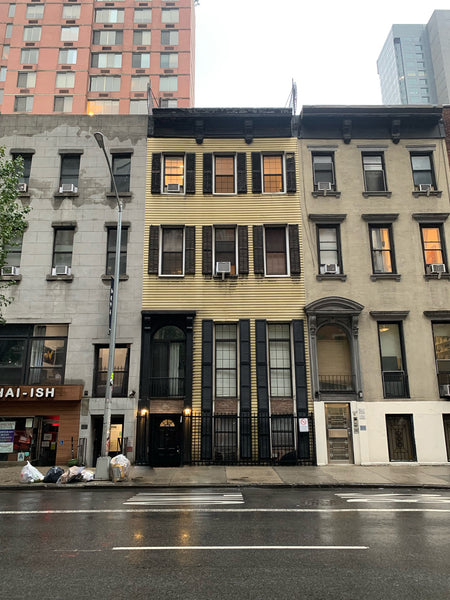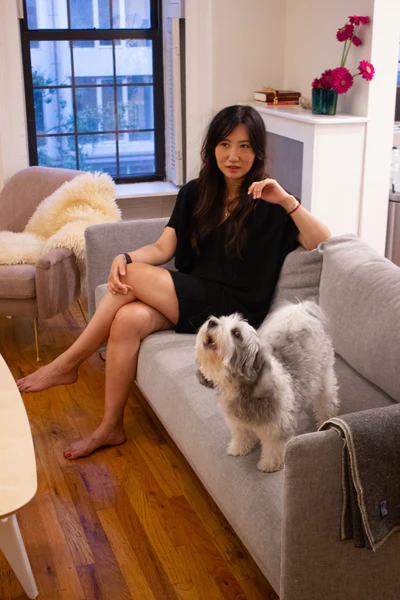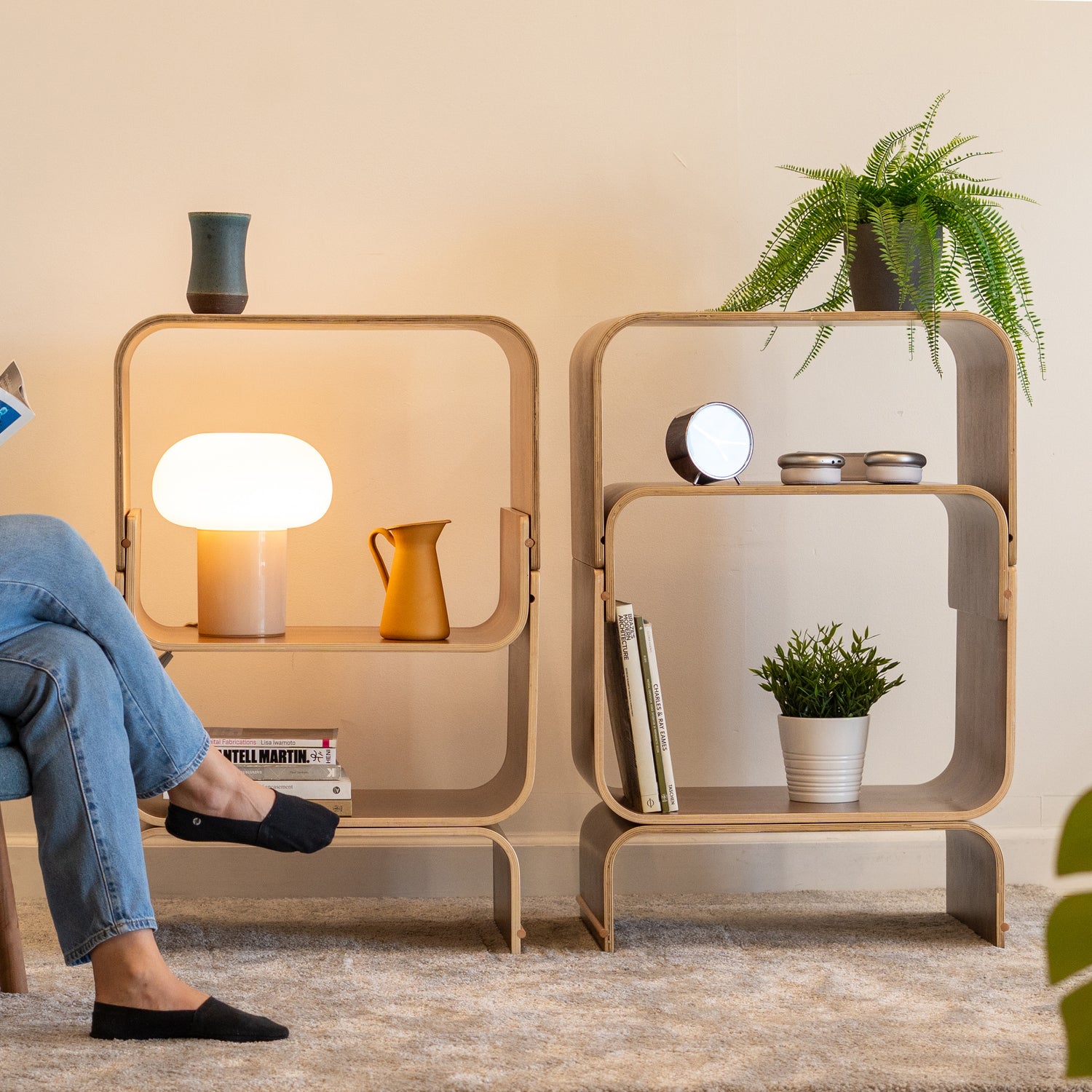
Can you introduce yourself?
Hi, I'm Lauren Lee. I am working in consumer product goods for PepsiCo, so foods and beverages for a small indie brand.

Your apartment is gorgeous! Where are you living?
Yeah, so I am in the Nomad area in downtown Manhattan. Very vibrant, certainly has a lot of young people, a ton of outdoor activities, as well as all these restaurants and bars that you can frequent. Close to Madison Square Park. Not quite Central Park, but close enough to a park.

There are a lot of big tower blocks around here. But this is one of the few, small pre-war buildings. It looks good!
Yeah, so I believe the building was built in the 1920s. There are only four units. So I'm on the fourth floor. So great exercise for your... gluteus maximus if you like walk-ups. I've been in New York for six years, and only lived in walkups partly because of the charm but also because you get a lot more space for your money. It's sort of a trade-off you have to make in New York, right? Amenities and space for the same amount of cost. And I really love it. I know my neighbors downstairs and it's really quite nice to have some sort of community even within your apartment building.

And you have the whole top floor.
I have the whole top floor. My first-floor neighbor has an entire backyard to herself. My second-floor neighbor Linda has a great Sun deck, which I don't have, but that's okay... I am in the penthouse.
What type of music do you like?
What type of music do I like? Oh, that's so tough. Let's start with 90s Hip Hop. And then we move into Indie Rock and Roll but like I'm old so like the early 2000s Indie. Right, like Beach House.
Beach House?
Yes, Beach house…. Who else... Camera Obscura is the one that's very indie…. Oh, The White Stripes. Yeah, who else do I listen to? It's really random.
Do you listen to any jazz or classical music or is it mostly, pop?
I guess I like Nina Simone a lot. Billie Holiday sometimes depends on my mood. Then of course you have your Kpop. I really loved Hwasa. She's so cool. Oh, and Mama Moo. Obviously the best band ever. Yeah.

So you have a lot of beautifully designed pieces in your house. It's all very well thought out. Where do you derive your source of inspiration for the design?
I've always had an affinity for creative design, right. There are two concepts, one deriving from Japanese culture which is called Mono No Aware, which is essentially the pathos of things. So things have their own nature, their own time and their own passing. So it's really kind of looking at things in nature. But when you bring that into your household, it means that you know, at least in my interpretation, the flow of things within your house. So when you buy a product or a piece of furniture, it has to resonate with you in a way that, it is what it is, and you are what you are. And so for me, it's less about the trend or less about what, how it looks. but basically how it feels to me. and how I feel about it, in the space I'm in. So that's kind of their sort of a natural way of saying that, for me, all things, physical or intangible, have to have their own pathos and you're following your own intuition of interpretation.

I love that. How does design integrate with your everyday life?
Yeah, I think design it's funny because I am, you know, I'm in consumer product goods, and I do strategy work. I worked with the Pentagon for a while before I pivoted into this career. In the Pentagon design, it's only important if you're getting to your end goal, right. And in CPG (consumer product goods) design is only important if it gets your consumers to buy your products. But design in everyday life means that there's utility, there's form, but there's also emotion, right? In fact, the design itself can help you be emotionally healthy, right, or help you feel a certain way. Because of the ease, it brings you, or the joy brings you, right? Or it can hamper you from doing everyday life. Like if you have a badly designed shoe that you're wearing, it's gonna make you feel terrible, it's going to not help you get to places. If you have a badly designed couch, you're just always going to think about it as a piece in your house that you don't like to sit on. And it just uses utility. So for me, the utility, the form, the emotion, so the design is always an ever-evolving process for the individual as well as the designer, right? So having that lens of design kind of is what makes me so attracted to hoek furniture, because there's utility, there's this natural inclination of making life easier for the consumer. And then on top of that, you know, it's beautiful, so it makes you feel good, right? So it hits all those three things. And it's ever-evolving because you guys are constantly changing up design thinking about how to integrate design into the furniture itself. So I think that's pretty awesome in essence

What are the most important aspects of designing a room? For example, space? Is that a functionality? When you're thinking about laying out this space? Why did you decide to do it the way you did?
As for space, I think interior design is unfortunately limited to the space you're in. So it's a physical problem, right? Or the physical space solution you're looking for if you're going to live in a new place. I think that in New York, most people have very small spaces, but they still want to inculcate a feeling that it's their home. So for me interior design, or design in general, for space, you think about a few things. Functionality, the way it looks, how it integrates your day-to-day. How does it make your life better? You know, some things really sort of just nice to have, like, plants are nice to have, right. But plants bring a vibrant part of nature into your house. And that brings a sense of unity and harmony with the fact that we came from the earth right. But then you have a working table, which I have to work on for work from home. And so what does that mean? Well, it means that it needs to be functional so that I can do my job well, right. Interior design is all about your personal preference.

I think it's super interesting that you’re in PepsiCo now. And you have time in the Pentagon... Is that top secret?
Yes, it is. So we don't talk about it.
So we're definitely not talking about now.
Even without a mic on. That's a No, no,...

I know you're a fantastic cook. You like to cook and you know can you tell us a little bit about that?
Yeah, no, but cooking. cooking, cooking is started. You know, my, my entire family who is the female side are just excellent cooks. Absolutely excellent cooks. They just really love to cook and I cook everything.

What’s your favorite thing to cook?
Favorite thing to cook? It depends. So right now, I, you know, have gotten back into cooking Chinese food. So I just made roasted pork belly for five hours. I just made some dumplings. We also, you know, have kind of explored into making diet foods. Because Chinese tends to be pretty heavy on sugar and soy right. But it's more or less healthy, but still has that like oriental flavor.
Are there any other great, cool, or interesting things about you?
Oh, I don't think so. I'm so boring.
Well, thank you so much for your time, Lauren!





